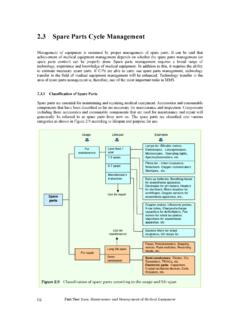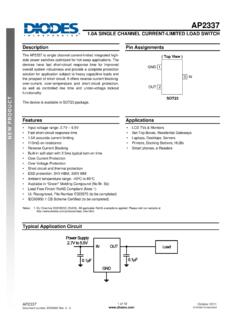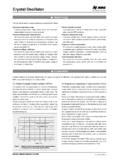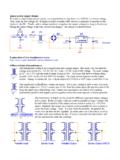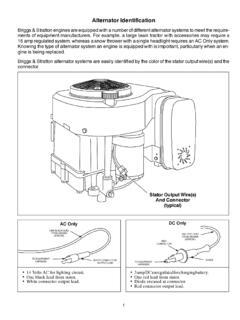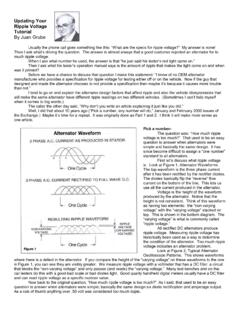Transcription of BATTERY AND CHARGER SELECTOR GUIDE - Nilfisk
1 BATTERY AND CHARGERSELECTOR GUIDEC lean, fume-free, quiet, safe and dependable BATTERY power is used in many commercial and industrial applications today,including floor cleaning and maintenance. Space ageadvances in BATTERY design and construction have madebatteries a practical means of powering a variety of Nilfisk -Advance mechanized maintenance its APAsales program, Nilfisk -Advance promotes the use of the proper BATTERY in the appropriate intention of this SELECTOR GUIDE is to provide a generalexplanation on the use and care of today s batteries.
2 Thisinformation is intended to help in selecting the right batteryfor equipment, based on the job that equipment is expectedto perform. This SELECTOR GUIDE is meant only as an aid toNilfisk-Advance Dealers, their sales personnel and end-users of Nilfisk -Advance offers a complete family of BATTERY chargers for the full line of BATTERY -powered Nilfisk -Advance heavy-duty chargers are especially matched to theequipment and batteries they are meant to service, ensuringmaximum life and performance as well as economicaloperation and safety.
3 Important APAcharger features and benefits:Feature:Benefit: Automatically tapered Provides good equalization of cells,charge BATTERY life, low water use. Automatically compensatesWill control spikes in voltage andfor AC supply voltage variations reduce risk of damage to or minus 10% from nominalvoltage. Silicon diodes operating wellProvides maximum surge protectionbelow service operating reliability. Positive shut-off of chargerNo over or under charging that can when charging is BATTERY damage. Automatic shut-off when either Safety feature in that it helps AC or DC plug is pulled or prevent personal injury to CHARGER time has elapsed.
4 Low current draw, operating Cost/wear when connected to BATTERY . CHARGER performance is Protect and preserve batteries formatched to Nilfisk -Advance optimum Convection-cooled maintenance. Built-in Ammeter standard Not necessary to purchase(measures electric current as an additional amperes).GENERAL INFORMATIONA BATTERY basically consists of a containerwith positive and negative plates inside,and a cover with positive and negativeterminals. To activate, the container isfilled with an electrolyte, a dilute solutionof distilled water and sulfuric acid.
5 Thiselectrolyte solution will stay in liquid form, or turn into a gel in the case of gel-cell this business, we deal mostly with twotypes of batteries. There are starterbatteries, which provide the current forstarting and running internal combustionengines. These batteries must deliver highcranking currentsat a satisfactory voltagefor a few seconds and a portion of theaccessory load (10-25 amps) for a minuteor two at a time. Power taken from thisbattery is immediately replaced by thealternator or generator, so the BATTERY is subjected to shallow discharge cycles (2-3% of the BATTERY capacity).
6 Thesebatteries operate in the 90-100% state of batteriessupply all the currentfor the electric-powered vehicles in whichthey are used. The rate of discharge varieswith the type of service what they areused for. The depth of discharge varieswith the length of time it is used beforebeing recharged. Once the BATTERY isdischarged, it must be recharged tocontinue operating the vehicle; and it isnot recharged by an alternator. Thesebatteries receive deep discharges (70-80% or more of their capacity).Cold Cranking Ampsis a rating applied toall starter, lighting, ignition and deep-cyclebatteries.
7 It gives the highest dischargelevel (in amps) that can be sustained by afully charged BATTERY over 30 secondswithout dropping cell voltage below volts at 0 to a popularly held belief, deep-cycle batteries do not have a memory . Itwas once believed that unless a deep-cyclebattery was discharged to its full amountof use before each recharge, it would nothold as full a charge and working timewould be reduced. This is not true, and it isrecommended batteries be fully chargedafter each machine use, whether theywere discharged to the maximum or batteries should be given a boost charge prior to their initial use, and abreak-in period is recommended.
8 Refer tothe manufacturers break-in Capacity at 75 ampis the amountof time in minutes that it takes a batteryto go from fully charged to volts percell using a constant 75 amp discharge at80 Fahrenheit. Discharged: volts for 6 volt and volts for 12 Charge: volts for 6 volt and volts for 12 houris a rating given in amps, the totalamount of amps a fully charged batterycan provide in a 20 hour period, reaching adischarge level of volts per cell at 80 Fahrenheit. Divide the rating by 20 hoursto determine discharge : 1) a 200 AH BATTERY will yield 10 amps for 20 : 2) a 105 AH BATTERY will yield amps for 20 houris a rate given in amps for the totalamount of amps a fully charged batterycan provide in a six hour period, reachinga discharge level of volts per cell at80 Fahrenheit.
9 Divide the rating by sixhours to determine the discharge : 1) a 600 AH BATTERY will yield 100 amps for 6 convert 20 hour to 6 hour rate, multiply20 hour rate by . : 450 AH @ 20 hrs. x .84 = 375 AH @ 6 capacity at 25 ampsis a ratinggiven in minutes, applied to starter,lighting ignition and deep cycle batteriesdemonstrating the time it takes for a fullycharged BATTERY to reach volts per cell using a constant 25 amp discharge at80 generate volatile gases. Keepopen flames or sparks away from electrolyte contains sulfuric batteries level to prevent spills, andavoid getting electrolyte solution on skinor clothing.
10 Always wear eye protectionwhen working near batteries. Do not letmetal tools contact the positive terminaland a grounded surface at the same installing a BATTERY always followthe equipment manufacturer sinstructions. The BATTERY should be securedfirmly in it s own compartment. A coatingof non-metallic grease or protective sprayon all connections will help minimizefuture corrosion. Replace old or worncables. Make sure the terminals andconnectors are clean, and then tightlyconnect the cables to the AND MAINTENANCEIt s important to follow the chargermanufacturer s instructions when charginga BATTERY .

